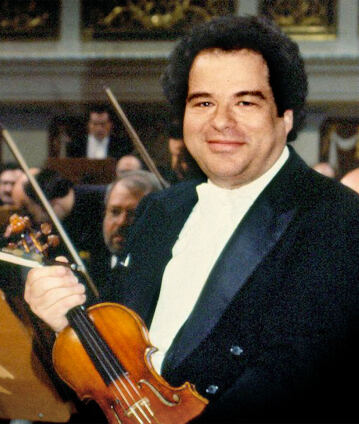Itzhak Perlman and Daniel Barenboim perform Brahms’s Violin Concerto

“Perlman made his violin sound jubilant, pouring out passion, gently shimmering and dancing à l’hongroise,” the Berlin press reported when the exceptional American violinist performed Brahms’s Violin Concerto, a magnificent piece filled with obvious and not so obvious passages of tremendous beauty. The conductor at this performance in the Berlin Schauspielhaus was Daniel Barenboim.
Daniel Barenboim and Itzhak Perlman have been friends and colleagues for practically all of their lives. In the spring of 1992 they gave four concerts with the Berliner Philharmoniker in the Schauspielhaus am Gendarmenmarkt, while the orchestra’s usual home was being renovated. At the first two concerts Perlman had dazzled his listeners with Beethoven’s Violin Concerto, before devoting his attention at the third and fourth concerts to Brahms’s Concerto, a very different work in spite of its shared key-signature of D major. The first part of the programme had comprised a Rossini overture and a world premiere: Josef Tal’s Fifth Symphony, a piece that the orchestra had commissioned from the composer.
In an introduction to the piece, the then eighty-one-year-old composer had written: “The superficial brilliance of musical effects is not enough, for it is incapable of supporting any real feelings or of making them more intense.” This is a motto that Itzhak Perlman might equally well have chosen as his own, for his phenomenal abilities are never an end in themselves but are invariably placed in the service of the music, with the result that in the Brahms Concerto the soloist performed “in a way that is uniquely his,” to quote Klaus Geitel in the Berliner Morgenpost, “constantly icing meticulousness and delight in making music with the beauty of his intonation.” According to the Volksblatt, “Perlman made his violin sound jubilant, pouring out passion, gently shimmering and dancing à l’hongroise. In return he was jubilantly acclaimed.”
Laid out along symphonic lines, Brahms’s Violin Concerto was initially not popular with potential performers. The famous violinist Pablo de Sarasate simply refused to play it, arguing that he had no wish to “stand on the rostrum, violin in hand and listen to the oboe in the Adagio playing the only tune in the whole work”. But other famous violinists, beginning with Brahms’s friend Joseph Joachim, refused to be misled by appearances and recognized the opportunities for self-representation that the work offers every capable soloist. Today the work ranks alongside Bach’s solo partitas and the Beethoven Concerto as one of the classic touchstones of every great violinist’s abilities.
© 1992 EuroArts Music International
Artists
Our recommendations
- Itzhak Perlman and Daniel Barenboim perform Beethoven’s Violin Concerto
- A Beethoven evening with Daniel Barenboim, Itzhak Perlman and Yo-Yo Ma
- Daniel Barenboim conducts Bruckner and Schubert
- Daniel Barenboim and Plácido Domingo at the 1992 Europakonzert in the Escorial
- Daniel Barenboim conducts the 1997 Europakonzert from Versailles
- Daniel Barenboim conducts Smetana’s “Má vlast”